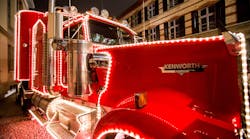Manager: Anthony “Tony” Eiermann
Title: Manager of asset and value management
Company: Coca-Cola Refreshments
Operation: Deliver products via a global ground fleet of over 200,000 vehicles
Problem:
Back in 2011, Coca-Cola joined the National Clean Fleets Partnership, a group that falls under the umbrella of Clean Cities, a U.S. Dept. of Energy program designed to bring together the federal government and private sector in an effort to reduce dependence on fossil fuels.
Coca-Cola deployed various tactics to help reduce the fuel consumption footprint of its global fleet by optimizing delivery routes, reducing packaging weight, and adding different alternative fuel vehicles (AFVs) to its fleet, such as hybrid-electric, all-electric, compressed natural gas (CNG), and liquefied natural gas (LNG).
Tony Eiermann, manager of asset and value management, says Coca-Cola now operates over 738 hybrid electric trucks—9% of its total delivery fleet—along with 25 all-electric vehicles, two LNG-fired and seven CNG-powered Class 8 tractors.
Eiermann notes that Coca-Cola likes to “keep vehicles forever, which means we run them until the wheels come off.” So, the company needed a way to get drivers to help make all of the equipment last as long as possible. But the fleet as a whole still needed to generate fuel savings while minimizing maintenance expenses.
Solution:
To accomplish all of those goals, Coca-Cola created the “Smart Driver” program to improve vehicle and operator safety while saving fuel. The added bonus would be reduced equipment wear and tear.
“We really needed to rethink how we operated our vehicles because if we don’t operate them properly, we don’t get all the benefits,” Eiermann explains, especially where AFVs are concerned.
Eiermann says Coca-Cola’s focus on developing the Smart Driver program, which first launched four years ago, flows from an adherence to what he calls its four ‘P’ policy: people, processes, performance, and partners.
And the processes followed by Coca-Cola’s people—in this case, the truck driving skills put into practice every day—can significantly impact company performance in a good way, he stresses.
“Just knowing when and when not to use the air conditioner, to ensure trucks are driven in the right gear, and that trucks are ‘tuned’ to their specific duty cycle by our maintenance personnel all help decrease wear and tear while boosting fuel savings,” Eiermann points out.
The program also aims to deliver information to drivers in a positive way. According to the company, by altering on-the-road behavior, the driver of a conventional diesel-fueled truck can reduce fuel consumption by 10%. This is a potential fuel saving of $1,500 per truck per year.
Eiermann notes that part of the process is developing anticipatory driving skills. “It’s about recognizing the type of traffic flow you are in, how you approach traffic lights, monitoring pedestrian activity around your vehicle, how you make lane changes, and especially paying attention to road-grade changes,” he says.
For example, one tip he offers is that “slow and go is better than stop and go.” If drivers maintain a long following distance and keep rolling in traffic, they can achieve a 20% fuel reduction. Other tips include keep idling to a minimum, follow the speed limit, and check tire pressure.
“Maintaining steady vehicle momentum is the key,” says Eiermann. “It requires less fuel to keep a vehicle moving steadily versus constant stopping and starting.”
Coca-Cola uses a telematics system to deliver a dashboard-style report on each driver that includes data on idling, adherence to routes, hard braking, and speeding—all part of its Smart Driver efforts to boost fleet efficiency while reducing costs.



